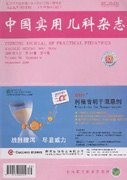Objective To detect the level of fecal primary and secondary bile acids in infants with infantile cholestatic hepatopathy(ICH)and analyze its clinical value. Methods Thirty infants with ICH were enrolled in this study,who were diagnosed with infantile cholestatic hepatopathy. Thirty infants with good health condition were enrolled as the healthy control group. The fecal samples were collected respectively in the preparatory treatment phase and treatment phase from infants with ICH and from the healthy infants. Bile acids were extracted from infants’ feces and were quantitatively analyzed by liquid chromatography-mass spectroscopy. Results Among the fecal primary bile acids,the level of cholic acid,chenodeoxycholic and glycochenodeoxycholic acid both in the ICH preparatory treatment group and ICH treatment group was significantly lower than that in the healthy control group(P<0.016).The level of fecal cholic acid and chenodeoxycholic acid of ICH treatment group was higher than in the ICH preparatory treatment group(P<0.016). Among the fecal secondary bile acids,the level of lithocholic acid both in the ICH preparatory treatment group and ICH treatment group was significantly lower than that in the healthy control group(P<0.016),and the level of ursodeoxycholic acid in the ICH preparatory treatment group was lower than that in the ICH treatment group and healthy control group(P<0.016). Conclusion In infants with ICH, the changes of fecal primary bile acids and fecal secondary bile acids have their own characteristics at the early stage of treatment, which may be caused by the short-term treatment, the prognosis of the disease itself and the changes of intestinal function, including intestinal bacteria. Clinical attention should be paid to these changes.

